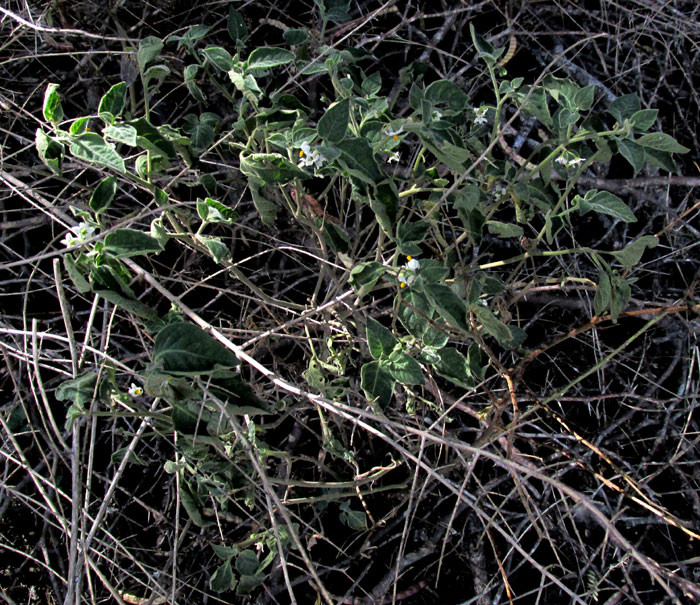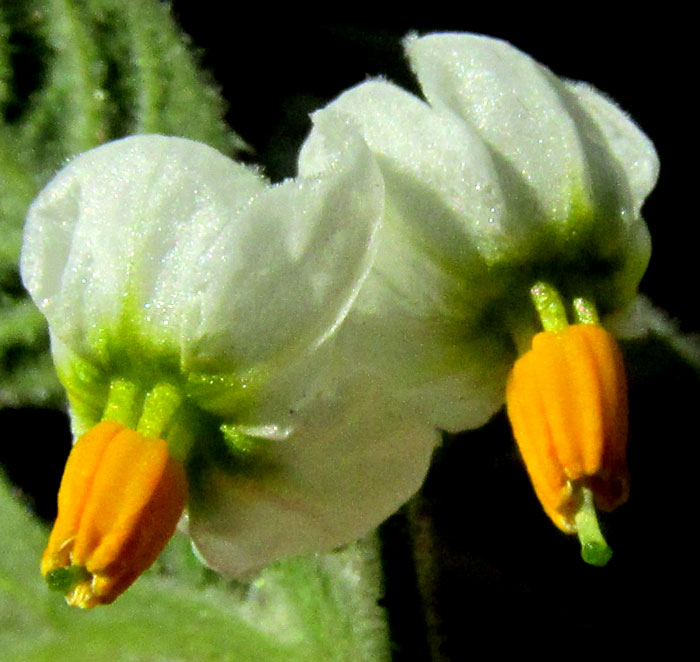Excerpts from Jim Conrad's
Naturalist Newsletter
entry dated August 8, 2022, issued from near Tequisquiapan, elevation about 1,900m (6200 ft), N20.565°, W99.890°, Querétaro state, MÉXICO
SOLANUM PRUINOSUM

When the above herb showed up with its small, white, star-shaped flowers bearing slender, yellow "noses," hiding in a tangle of spiny brambles inside a hedgerow of spiny mesquite trees -- explaining why it managed to survive in this land of roving herds of sheep -- it was clear that here was one of several species known as black nightshades. Black nightshades are members of the big, complex, and sometimes confusing genus Solanum. Potato, eggplant and tomato plants are assigned to Solanum, but the genus embraces maybe 1500 mostly tropical and subtropical species, with maybe 150 in Mexico, so to figure out which species this one was, a close look at certain details was needed:

The star-shaped corolla's lobes were curved backwards. Five orange-yellow anthers of varying lengths were connected to one another along their margins, with a hard-to-see pore at each anther tip, from which pollen could be shaken by vibrating bees -- "buzz pollination." All this is typical of the genus Solanum.

From the back it's clear that the vegetative parts and even the corolla are hairy. In figuring out the various Solanum species it's important to notice whether the hairs are simple or branched and, if branched, what kind of branching. These look like simple hairs with no branching. Plus, as seen below, the simple hairs bear no glands atop them:

With literature available on the Internet, I had problems identifying this Solanum, especially because it wasn't clear to me whether the pictures show glandular hairs. I see one hair which appears glandular, but not others. When these pictures were uploaded to the iNaturalist website, "plantperson7654," whose special interest is lesser known Solanum species, recognized SOLANUM PRUINOSUM. The evidence given was that the hairs were glandular, the flowers were large, and the anthers were relatively long, not globose. With my uncertainties, I'll go with plantperson7654's ID.
According to the 2019 study by Sandra Knapp and others entitled "A revision of the Morelloid Clade of Solanum L. (Solanaceae) in North and Central America and the Caribbean," Solanum pruinosum is endemic just to northeastern and central Mexico, across the central Volcanic Belt. It's described as occurring in pine-oak and other upland and open area habitats. It's main identification feature is its glandular pubescence, and the authors of the cited paper suggest that the species are just isolated glandular populations of Solanum nigrescens and Solanum douglasii, but further work is needed to know.